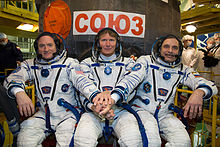cosmos.wikisort.org - Spacecraft
Soyuz TMA-16M was a 2015 flight to the International Space Station.[4] It transported three members of the Expedition 43 crew to the Station. TMA-16M was the 125th flight of a Soyuz spacecraft, the first having launched in 1967.
 Soyuz TMA-16M approaches the ISS, 28 March 2015. | |
| Operator | Roskosmos |
|---|---|
| COSPAR ID | 2015-016A |
| SATCAT no. | 40542 |
| Mission duration | 168d 5h 9m |
| Spacecraft properties | |
| Spacecraft type | Soyuz-TMA 11F732A47 No.716 |
| Manufacturer | RKK Energia |
| Crew | |
| Crew size | 3 |
| Members | Gennady Padalka |
| Launching | Mikhail Korniyenko Scott Kelly |
| Landing | Andreas Mogensen Aydyn Aimbetov |
| Callsign | Altair[1] |
| Start of mission | |
| Launch date | 27 March 2015 19:42:57 UTC[2] |
| Rocket | Soyuz-FG |
| Launch site | Baikonur 1/5 |
| End of mission | |
| Landing date | 12 September 2015 00:51 UTC |
| Landing site | Kazakhstan |
| Orbital parameters | |
| Reference system | Geocentric |
| Regime | Low Earth |
| Docking with ISS | |
| Docking port | Poisk zenith |
| Docking date | 28 March 2015 01:33 UTC |
| Undocking date | 28 August 2015 03:12 UTC |
| Time docked | 153d 1h 39m |
| Docking with ISS (Relocation) | |
| Docking port | Zvezda aft |
| Docking date | 28 August 2015 03:30 UTC[3] |
| Undocking date | 11 September 2015 21:29 UTC |
| Time docked | 14d 17h 59m |
 (l-r) Kelly, Padalka and Kornienko Soyuz programme (Crewed missions) | |
Scott Kelly and Mikhail Korniyenko performed the first one-year stay at the Space Station,[4] returning in Soyuz TMA-18M.
Crew
| Position[5] | Launching Crew Member | Landing Crew Member |
|---|---|---|
| Commander | Expedition 43 Fifth and last spaceflight | |
| Flight Engineer 1 | Expedition 43 Second and last spaceflight |
Iriss[6] First spaceflight |
| Flight Engineer 2 | Expedition 43 Fourth and last spaceflight |
N/A First spaceflight |
Backup crew
| Position[8] | Crew Member | |
|---|---|---|
| Commander | ||
| Flight Engineer 1 | ||
| Flight Engineer 2 | ||
Mission highlights
Launch, rendezvous and docking
Soyuz TMA-16M was launched successfully aboard a Soyuz-FG rocket from the Baikonur Cosmodrome in Kazakhstan at 19:42 UTC on Friday, 27 March 2015. The spacecraft reached low Earth orbit approximately nine minutes after lift-off. After executing rendezvous maneuvers, the Soyuz docked with the zenith port of the International Space Station's Poisk module approximately six hours after launch, at 01:33 UTC on 28 March. The docking occurred over Colombia.[9][10]
Soyuz TMA-16M remained docked to the ISS—serving as an emergency escape vehicle–until September 12, 2015, when it departed and returned Padalka, Andreas Mogensen and Aydyn Aimbetov to Earth.[7] This vehicle was previously scheduled to carry Sarah Brightman as a space tourist, but Brightman's flight was announced to be cancelled in May 2015.[11]
Relocation maneuver
Soyuz TMA-16M spacecraft was relocated from Poisk module to the orbiting laboratory's Zvezda module service module on 28 August 2015.[3] This cleared the Poisk module for the arrival of Soyuz TMA-18M.
Undocking and return to Earth
Soyuz TMA-16M undocked from the ISS at 21:29 UTC on 11 September 2015, containing Gennady Padalka of Roscosmos and visiting crew members Andreas Mogensen of ESA (European Space Agency) and Aidyn Aimbetov of the Kazakh Space Agency. Following a deorbit burn, the Soyuz spacecraft's descent module reentered the Earth's atmosphere. The crew landed safely in Kazakhstan at 00:51 UTC on 12 September 2015, just over three hours after departing the ISS.[12]
Gallery
- Soyuz TMA-16M rocket shortly after rollout.
- TMA-16M launches from the Baikonur Cosmodrome.
- Korniyenko (right), Padalka (center) and Kelly (left) inside the spacecraft prior to the relocation maneuver.
- Departure of Soyuz TMA-16M.
- Reentry of Soyuz TMA-16M as seen from the ISS.
References
- Soyuz TMA-16M mission updates Archived 2015-09-24 at the Wayback Machine Spaceflight101, 28 march 2015
- Clark, Stephen. "Live coverage: Crew ready to begin record-setting space mission". SpaceflightNow. Retrieved 27 March 2015.
- "Soyuz Relocation". NASA. Retrieved 29 Aug 2015.
- NASA, Roscosmos Assign Veteran Crew to Yearlong Space Station Mission NASA, 2012-11-26.
- Планируемые полёты (in Russian). astronaut.ru. Retrieved 2012-06-30.
- Agencia Espacial Europea. "Andreas Mogensen's mission name links cosmos and Earth". Retrieved 22 June 2015.
- TASS (22 June 2015). "Kazakhstani cosmonaut to fly to ISS in September in place of British singer Brightman".
- astronaut.ru (2013). "Орбитальные полёты".
- "Soyuz TMA-16M kicks off historic one year expedition". NASASpaceflight.com. 27 March 2015. Retrieved 27 March 2015.
- "One Year Crew Arrives at Station". NASA. Retrieved 28 March 2015.
- "Brightman steps down from station flight". Spaceflightnow.com. Retrieved 28 May 2015.
- "Soyuz Return to Earth". NASA. Retrieved 11 Sep 2015.
External links
 Media related to Soyuz TMA-16M at Wikimedia Commons
Media related to Soyuz TMA-16M at Wikimedia Commons
На других языках
- [en] Soyuz TMA-16M
[ru] Союз ТМА-16М
«Союз ТМА-16М» — российский пассажирский транспортный пилотируемый космический корабль, на котором был осуществлён полёт к Международной космической станции, начавшийся 27 марта 2015 года. Во время полёта на МКС доставлены три участника долговременной экспедиции МКС-43/44 и возвращены на Землю три космонавта (1 участник долговременной экспедиции МКС-43/44 и 2 участника кратковременной экспедиции посещения ЭП-18). Это 123-й пилотируемый полёт корабля «Союз», первый полёт которого состоялся в 1967 году.Другой контент может иметь иную лицензию. Перед использованием материалов сайта WikiSort.org внимательно изучите правила лицензирования конкретных элементов наполнения сайта.
WikiSort.org - проект по пересортировке и дополнению контента Википедии







